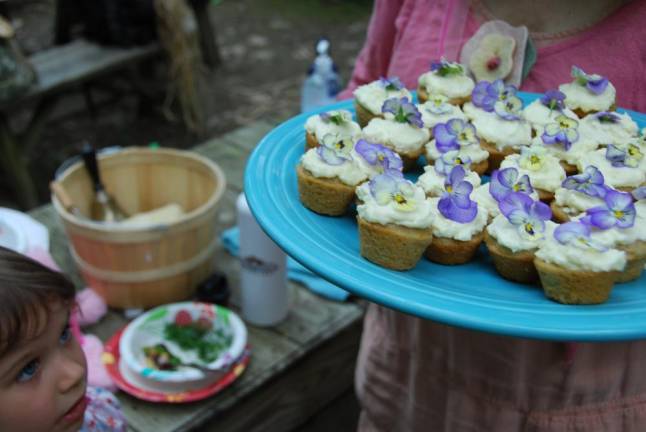The cupcake topper
The parti-colored violet comes in yellow, blue and white



Each day, yet another flower unfolds. In numbers, festive violets appear in purple and white, even in yellow, dappling our grassy lawns and trail sides. But violets, scientifically speaking, Viola, are more than just a pretty face; they are edible and medicinal.
The five-petaled violet has only bilateral symmetry and a distinctive spur on its backside. It can take many forms, not only in color, but leaf shape and arrangement. The common blue violet, Viola sororia, is the quintessential violet, easiest to identify as well as abundant. All violets in the Northeast that are white and/or blue are safe for consumption, however, a few species are threatened and yet others could be confused with poisonous purple flowers such as Monk’s Hood or Delphinium. Also bear in mind, that this article does not refer to the African violet, Saintpaulia, which is neither a true violet nor edible.
The common blue violet has long-stemmed, heart-shaped leaves with tiny teeth along the outer edge. Leaves grow basally, never along the flowering stalk. Flower stalks are never branching. Remember, just one flower to one stem, although there may be multiple long-stemmed flowers arising from one basal rosette of leaves. Despite its name, flowers range from bluish purple to white.
Flowers are best plucked from stems and savored raw. These may be sweet or slightly spicy depending upon the community of violets. Freeze flowers in ice cubes for cocktails or candy them to top cupcakes. Leaves are rich in vitamins A and C and the flavonoid rutin, which is cancer-fighting and anti-inflammatory. Simply snip them at the stem. Leaves have a pleasant green flavor and do not grow bitter with age like many wild greens. Use them like spinach, tossed in salads, wilted in pasta dishes or scrambled with eggs. Leaves are astringent as well as demulcent, which basically means they become slimy when wet. These properties lend them an anti-inflammatory quality that not only protects our digestive tracts but also quells heartburn and sore throats. Moisten leaves for a poultice or infuse in olive oil and apply topically to bug bites, sunburn, and poison ivy.
Food, medicine and beauty: violets have it all.